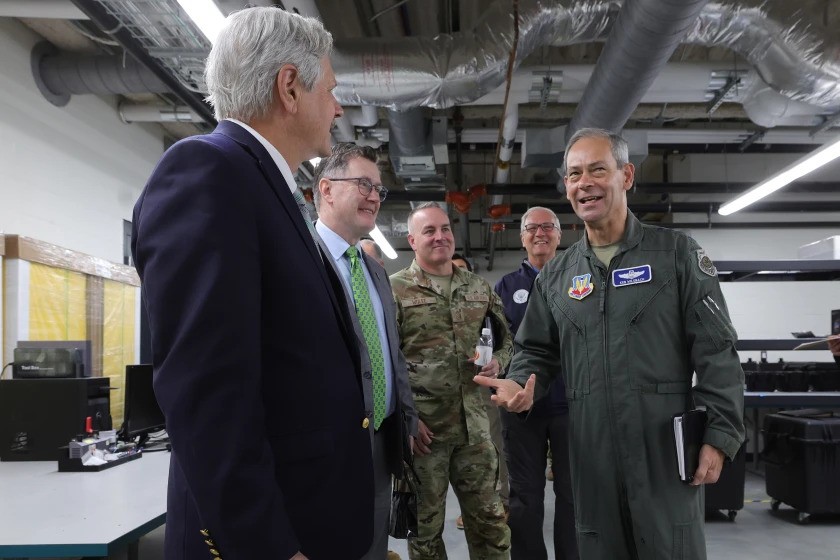
In Grand Forks visit, Air Force general raises concerns about counter-UAS capabilities
GRAND FORKS – U.S. Air Force Gen. Kenneth Wilsbach came to Grand Forks earlier this week with a question about drones: how to do a better job of knocking them out.
In two roundtable discussions Tuesday with aerospace experts at UND’s John D. Odegard School of Aerospace Sciences and at GrandSky aviation park, the commander of Air Combat Command repeatedly raised concerns about the use of unmanned aerial systems against the U.S. military.
“We’re seeing a proliferation of UAS being used and we’re seeing difficulty with countering that,” Wilsbach told the Herald. “We ought to take it seriously now, before it becomes a crisis in our country.”
Wilsbach was in Grand Forks at the invitation of Sen. John Hoeven, R-N.D., to discuss current and future Air Force operations in the Red River Valley.
“The Red River Valley is home to essential Air Force and Air Guard operations, as well as a robust UAS industry with research, development, testing and training capabilities unmatched by anywhere else in the world,” read a statement attributed to Hoeven.
Drone incursions pose an increasing problem for the military, particularly on domestic bases, where proximity to civilians limits the options base commanders have to disable drones.
Wilsbach said domestic military bases rely heavily on electronic jamming, but that those systems can be unreliable and require Federal Aviation Administration authorization that doesn’t always come, since electronic interference has the potential to interfere with commercial aircraft. Using missiles and bullets to shoot down drones is also a no-go, since it could potentially create unsafe conditions on the ground, or unintentionally hit another aircraft.
“What we need is kit that works. We don’t have that,” Wilsbach said at UND. “Once we have that, then we need the authority to use it. We also don’t have that.”
The problem drones are often small, inexpensive vehicles – oftentimes they’re hobbyists who may not know they’re flying in restricted airspace – that can be hard to detect or disable.
Even when the military is free to use guns and missiles overseas, the military still expends millions of dollars in ordinance to shoot down much less expensive drones.
Wilsbach compared drones to the proliferation of IEDs in Iraq and Afghanistan for their potential to cause disproportionate damage at relatively little cost.
A senior defense official told reporters that domestic military bases see two to three drone incursions a week, per a May 8 report from Air and Space Forces Magazine.
Col. Tim Monroe, wing commander of the 319th Reconnaissance Wing at Grand Forks Air Force Base, told the Herald the air base had firsthand experience with the issues Wilsbach described.
“Our story is exactly as he described in that we have technology that sometimes works and sometimes we’re not allowed to use it,” Monroe said.
The incursions have become a significant concern for the Senate Armed Services Committee, the chair and ranking Republican of which penned an April opinion piece in the Washington Post calling for a “master plan” to confront drone use amid Cold War-era technology and significant red tape.
Sen. Kevin Cramer, R-N.D., who accompanied Wilsbach for his visits to UND and GrandSky and is a member of the Senate committee, said the lack of counter-UAS measures leaves bases open to espionage or attack.
A working group in the Defense Department has been set up to address the issue, but Cramer feels its progress has been slow and believes the issue may need Congressional intervention.
“There are a lot of ways (our enemies) test us and sometimes we fail, and in the drone area we’ve been failing,” Cramer said.
Researchers at UND Aerospace are working on several UAS and counter-UAS projects with military applications, including predictive technology to anticipate where in-flight drones are headed and “drone swarms” that could be used offensively.
Last summer, UND and the Northern Plains UAS Test Site tested a laser weapon that could be used to shoot down drones by targeting and overheating the vehicle’s motor or battery. Wilsbach viewed video footage of one such test during his visit to GrandSky.
Further tests are planned at Camp Grafton in July: Cramer said he is working to send a staff delegation from Washington to view the tests on behalf of the Armed Services Committee.
“The opportunity to work this out at GrandSky and over at Camp Grafton is remarkable,” Cramer said.
Related Articles
Schlossman: Why the NCHC expedited St. Thomas’ application
For Trump, N.D. Gov Doug Burgum emerges as a safe option, and a wild card
Cartel member arranged for fentanyl to flow into Minnesota, North Dakota from a prison cell, court documents show
Minnesota, Wisconsin fall hunting seasons set — time to plan ahead
Third fatal shooting of officer in Minnesota is most in state in 40+ years


